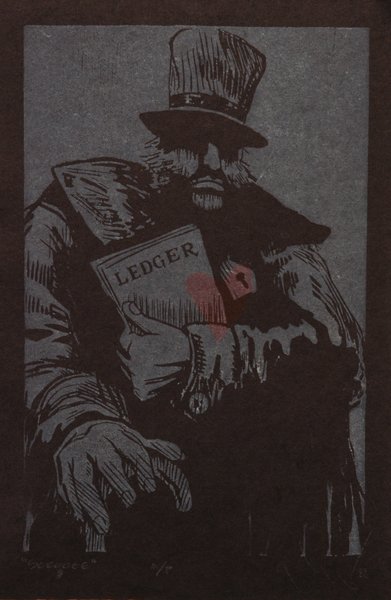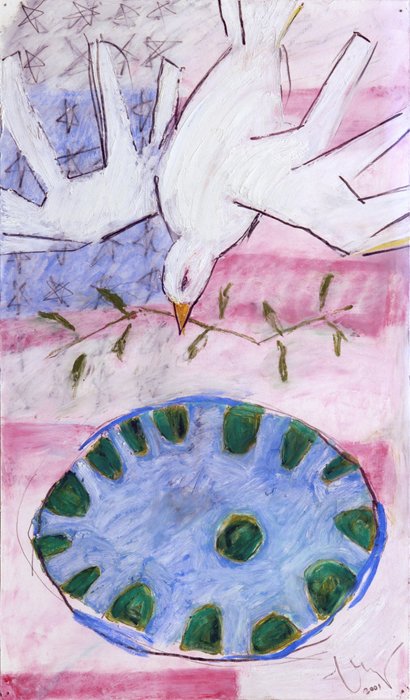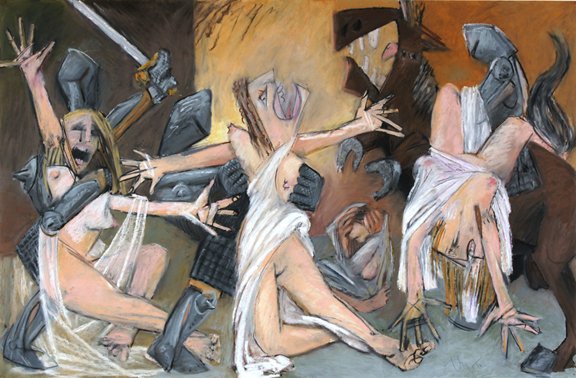
Classic Subjects

Leda and the Swan | Oil on Canvas | 37” h x 58.25” w | 2002

Scrooge | Woodcut with stencil | 7.75” h x 5” w | 1990

Peace Piece | Oil pastel and graphite | 14.5” h x 8.5” w | 2001 | Exhibition history: Minnesota State Fair, 91st Annual Fine Arts Exhibition, 2002. Honorable Mention award for oil pastel “Peace Piece,” 91st Annual Fine Arts Exhibition, Minnesota State Fair, 2002. Private collection.

The Death of Christ | Linoleum and wood cut with stenciled color | 14” h x 7.5” w | 1983 |

Good Friday | Copper engraving | 12” h x 9” w | 1981 | 2 color engraving in an edition of 30.

Dove and Olive Branch | Oil on Canvas | 20” h x 24” w | 1990

The Fourteen Stations of the Cross | 14 oil pastels, with some graphite on off white paper | Art: 9” h x 9” w, Frame size: 19” h x 18” w | 1980 | Recent exhibition history: Pax Christi Catholic Community, Eden Prairie, MN. Lenten Season, 2013. First Presbyterian Church of South St. Paul, MN. Lenten Season, 2014. Publication: Augsburg Fortress cover reproduction of “Station 12: Jesus Dies on the Cross,” Good Friday issue of the Sunday Service Folders, 2013.

Station #1 | Jesus is Condemned | oil pastels, with some graphite on off white paper | Art: 9” h x 9” w, Frame size: 19” h x 18” w | 1980

Station #2 | Jesus Carries His Cross | oil pastels, with some graphite on off white paper | Art: 9” h x 9” w, Frame size: 19” h x 18” w | 1980

Station #3 | Jesus falls the first time | oil pastels, with some graphite on off white paper | Art: 9” h x 9” w, Frame size: 19” h x 18” w | 1980

Station #4 | Jesus meets his Mother | oil pastels, with some graphite on off white paper | Art: 9” h x 9” w, Frame size: 19” h x 18” w | 1980

Station #5 | Simon of Cyrene is made to carry the cross | oil pastels, with some graphite on off white paper | Art: 9” h x 9” w, Frame size: 19” h x 18” w | 1980

Station #6 | Veronica wipes the face of Jesus | oil pastels, with some graphite on off white paper | Art: 9” h x 9” w, Frame size: 19” h x 18” w | 1980

Station #7 | Jesus falls the second time | oil pastels, with some graphite on off white paper | Art: 9” h x 9” w, Frame size: 19” h x 18” w | 1980

Station #8 | Jesus meets the women of Jerusalem | oil pastels, with some graphite on off white paper | Art: 9” h x 9” w, Frame size: 19” h x 18” w | 1980

Station #9 | Jesus falls a third time | oil pastels, with some graphite on off white paper | Art: 9” h x 9” w, Frame size: 19” h x 18” w | 1980

Station #10 | Jesus is stripped of his garments | oil pastels, with some graphite on off white paper | Art: 9” h x 9” w, Frame size: 19” h x 18” w | 1980

Station #11 | Jesus is nailed to the cross | oil pastels, with some graphite on off white paper | Art: 9” h x 9” w, Frame size: 19” h x 18” w | 1980

Station #12 | Jesus dies on the cross | oil pastels, with some graphite on off white paper | Art: 9” h x 9” w, Frame size: 19” h x 18” w | 1980

Station #13 | Jesus is taken down from the cross | oil pastels, with some graphite on off white paper | Art: 9” h x 9” w, Frame size: 19” h x 18” w | 1980

Station #14 | Jesus is placed in the tomb | oil pastels, with some graphite on off white paper | Art: 9” h x 9” w, Frame size: 19” h x 18” w | 1980

Zampano and Gelsomina | Oil on Canvas | 47” h x 57.74” w | 1983 | From IMDB... Sad story of a waif, Gelsomina, who is sold by her mother to Zampano for 10,000 lire and a few kilos of food. Zampano is a traveling showman who exhibits feats of strength by breaking a chain wrapped around his chest. He performs in village squares and then passes the hat for whatever the normally small crowd is prepared to give. He teaches Gelsomina a drum roll as part of his introduction. He doesn’t treat her well and when she tries to run away, he beats her. They eventually join a small traveling circus where they meet a tight-rope walker who convinces Gelsomina to question her choices.

Narcissist | Silver and gold mirrors | 17” w x 18.5” h | 2016

The Abduction of the Sabine Women | oil pastel on paper | 26” h x 40” w | 2003 | The Abduction of the Sabine Women is an episode in the legendary history of Rome in which the first generation of Roman men acquired wives for themselves from the neighboring Sabine families. Recounted by Livyand Plutarch (Parallel Lives II, 15 and19), it provided a subject for several Renaissance and post-Renaissance works of art that combined a suitably inspiring example of the hardihood and courage of ancient Romans with the opportunity to depict multiple figures, including heroically semi-nude figures, in intensely passionate struggle. The Rape is supposed to have occurred in the early history of Rome, shortly after its founding by Romulus and his mostly male followers. Seeking wives in order to found families, the Romans negotiated unsuccessfully with the Sabines, who populated the area. Fearing the emergence of a rival society, the Sabines refused to allow their women to marry the Romans; consequently, the Romans planned to abduct Sabine women. Romulus devised a festival of Neptune Equester and proclaimed the festival amongst Rome’s neighbors. According to Livy, many people from Rome’s neighbors attended, including many of the Sabines. At the festival, Romulus gave a signal, at which the Romans grabbed the Sabine women and fought off the Sabine men. The indignant abductees were soon implored by Romulus to accept Roman husbands. Livy is clear that no sexual assault took place. On the contrary, Romulus offered them free choice and promised civic and property rights to women. According to Livy he spoke to them each in person, “and pointed out to them that it was all owing to the pride of their parents in denying the right of intermarriage to their neighbors. They would live in honorable wedlock, and share all their property and civil rights, and — dearest of all to human nature — would be the mothers of free men.”

Leda and the Swan | Woven 1-inch strips of archival digital prints | 19.4” x 19.4” 2017 |

Lady Godiva | Woven 1-inch strips of archival digital prints | 19.6” x 19.6” | 2019